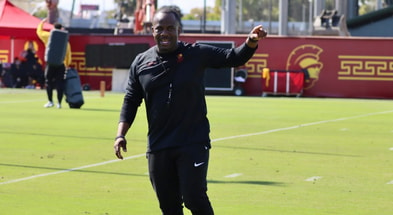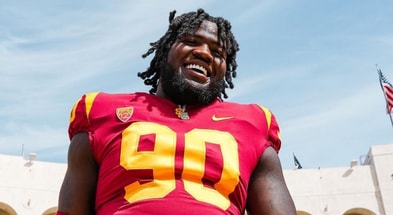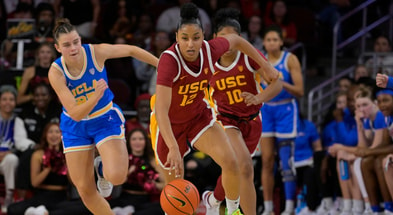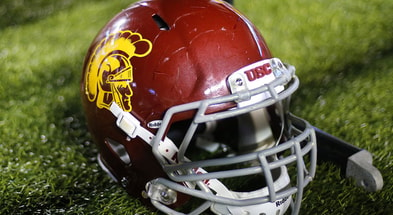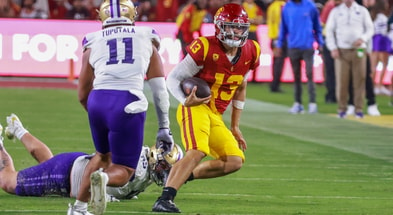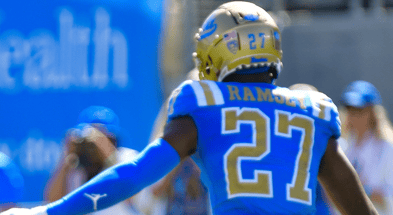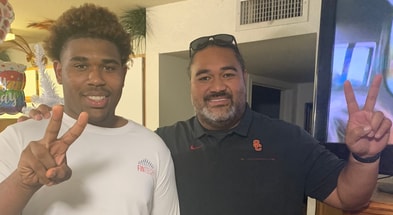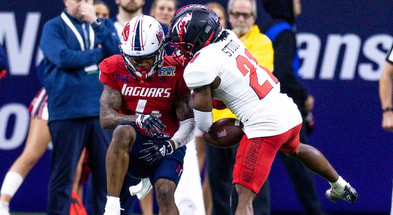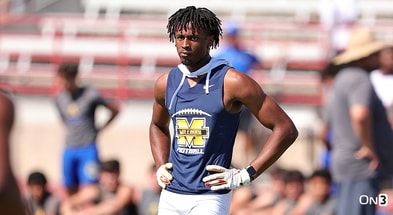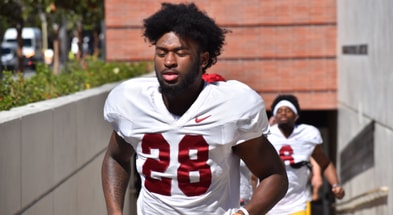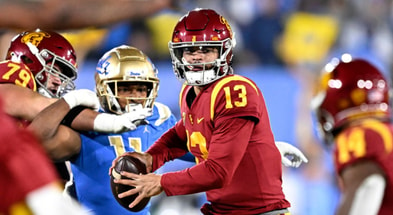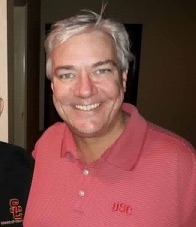Musings from Arledge: Cornerback Play, ITS, and Rising Tuition
As regular readers of Musings already know (don’t snicker – there are half a dozen or so), I’ve been out of the country. I went to Europe, in part, to run the 60 meters in the World Masters Athletic Championships in Poland. I did compete there – well, “compete” is too strong a word, as it implies a level of performance that I did not attain – but I’ll save my disastrous competition story for a later Musings. Because I’ve been away, I have not seen any spring practices and have only been able to follow the (very good) second-hand accounts we’ve been getting on wearesc.com.
I have been following with particular interest the discussion of USC’s cornerbacks, particular Isaac Taylor-Stuart, who appears to be putting together a very nice spring camp. If ITS is emerging as a top-notch corner, that is extremely good news for the Trojans, both because this is a position without experienced depth and because ITS offers athleticism that I think was lacking in the secondary last year.
Now because I’m discussing secondary play, I consulted a ringer this week. I spoke with Darrell Rideaux and had him read a draft of this section of Musings. There were some areas of agreement and disagreement. (You’ll see some of that in a second.)
Darrell was a far better player than I was. He played for better coaches than I did. If there’s one advantage I have over Darrell, it’s this: I know about playing in the secondary with a lack of athleticism. I know this the way Sark knows his way around the local frat scene; I lived it, day after day. Simply put, as a former corner who lacked elite speed – wait, scratch that – as a former corner who lacked decent speed, I know what a lack of athleticism can do at that spot.
So let’s start with a point on which Darrell and I both agree: speed isn’t everything. It is, in fact, sometimes overrated by casual football fans, and sometimes even by Hall of Famers, as the Raiders discovered for the last decade or so of Al Davis’s reign. Football requires more than straight-line speed. Even at the skill positions where speed is most valued, quickness, toughness, and position-specific skills (vision, hands, etc.) are more important than speed. And on defense, the farther you are from the ball, the more likely it is that a mistake will be a 6-point mistake. So more than anything, I want my corners and safeties to have good judgment. Corners with bad judgment are touchdowns waiting to happen.
And Darrell is of the opinion that USC’s secondary play has not suffered from any lack of ability. Darrell insists that USC’s poor secondary play was due to “a lack of fundamental discipline.” In his eyes, it’s “absurd” to suggest that “USC would recruit corners who lack athleticism.” For Darrell, technique was the problem last year and technique is the solution this year; speed was not and is not an issue. “While speed can be a factor it is not the factor that determines the effectiveness of a cornerback. It is actually their technique and ability to transition in and out of their breaks that can prove to be the deciding factor between an interception, a deflection, or giving up chunk yardage or worst a touchdown. When a member of the secondary has solid technique and plays with leverage within their alignment and stance, they place themselves in position to see the field and react at angles that allow places them in position to make plays.”
Darrell is right, of course, to a point. Technique matters greatly. But technique cannot overcome physical deficiencies. You can play great technique and get schooled by BMW or Keyshawn. Brandon Pili could work on his man-to-man coverage technique 15 hours a day, and he would still never be able to play corner. Technique matters. So does athleticism. It is no accident that most of the truly great corners – the Deions, the Darrell Greens – could really run. Speed is an eraser for a corner. Whereas on offense speed allows a player to turn a nice gain into a long touchdown, speed in the defensive backfield – closing speed -- allows you to more easily make up for errors. This means, of course, that fast corners can play more aggressively, because they can be less concerned with the receiver running past you. If you’re Darrell Rideaux and can run a 10.3 100 meters, you can take a risk that a slower corner simply cannot take, and you can fix mistakes that a slower corner could not fix.
This is why virtually all successful NFL corners are well-above the position average in the speed category. The average corner at the NFL combine runs an average 40 time of 4.48. Here are the reported 40 times for all of the starting corners in this year’s Pro Bowl:
Xavien Howard – 4.41
Jalen Ramsey – 4.41
Stephon Gilmore – 4.40
Denzel Ward – 4.32
Chris Harris, Jr. – 4.48
Kyle Fuller – 4.49
Patrick Peterson – 4.34
Darius Slay – 4.36
Byron Jones – 4.36
And, in addition to Deion and Darrell Green mentioned above, here are some greats from recent years and their reported 40 times:
Darrell Revis – 4.38
Champ Bailey – 4.28
Charles Woodson – 4.31
Rod Woodson – 4.25
There are not a lot of sub-par 40 times on either list. Just about everybody is at least average, and most are far above average.
I agree, of course, that USC’s corners did indeed show bad technique over the last couple of years. My contention is that it is sometimes difficult to tell whether it is technique that causes the lack of success or whether a lack of athleticism is causing the corner to abandon sound technique. Let me give an example from my own mediocre history.
As a slower corner, I sometimes had difficulty playing a receiver straight up in man coverage. Take, for example, tight man (or bump and run) coverage. A slower corner cannot afford to get a bad bump and let the receiver quickly get into his route, because the receiver will run past him. So a slower corner might try to cheat. I would often, for example, line up farther inside than is traditionally taught and maybe even open up my hips a little bit towards the receiver and the sideline (even though it’s best to have your hips square, or in line with the line of scrimmage). My intention was to show that I’m aggressively taking away an inside release so the receiver will feel forced to go outside. The receiver likely wants to go outside anyway, because he knows he’s faster and taller than I am, making the fade a pretty attractive option. But by opening my hips that direction, I could immediately jump on top of the fade and get in the way of the receiver’s route, effectively taking away that route. But note that I have to give up something to make this happen. I have to immediately jump on top of that outside route, making a jab step outside and a slant route a much tougher route to defend. A faster corner doesn’t have to cheat in this way, knowing that his superior speed will allow him to run with the receiver on the fade and therefore allowing him to play the receiver straight up and challenge inside and outside releases equally.
Or take the failure to look back at the ball – the most bewildering thing for fans who don’t understand why a corner doesn’t simply look back at the ball and make a play. But often a corner doesn’t look back because he either screwed up (allowed a clean release or bit on a fake) and let the receiver behind him, or he doubts that he can run with the receiver and can’t risk looking back. Remember, nobody runs as fast with their head turned back the other direction. You’ll never see an Olympic sprint run that way. So once the corner looks back, he slows down. Whereas if the receiver looks back and the receiver keeps his eyes on the corner, he might be able to make up a step on a receiver that got behind him. So often when we get frustrated at a corner for not turning his head to look for the ball, it’s simply that the corner has no faith in his ability to run with the receiver, and he’d rather watch the receiver’s eyes and hands and try to knock the ball away at the last second rather than risk looking back and allowing a speedy receiver to get separation.
Similar principles apply in other scenarios as well. The point here is that a trained eye watching me play would undoubtedly have taken issue with my poor technique. But the problem wasn’t necessarily that I didn’t know the proper technique. Sometimes the problem was that I was at a substantial athletic disadvantage and had to cheat to protect against the threat that I most feared, thereby giving up other things in the process.
Was a lack of physical ability the cause of some of the poor technique we’ve witnessed over the last couple of years? We’ll find out. Jackie Jones, of course, was fantastic athlete with a 10-cent head. Biggie Marshall is a very good football player who might be more cut out to play safety in my opinion in light of his size, solid tackling, and adequate but not overwhelming athleticism for a corner. And the older corners and nickels on last year’s roster were, in my opinion, limited athletically, an opinion that I think is supported by their pro day times and interest from NFL scouts. That’s not to say those guys weren’t good Trojans or good football players. I think they were both. It’s just tough to play what is possibly the most unforgiving position on the football field when your opponents are often taller, quicker, and faster than you are.
So we’ll learn a lot this year. Darrell and I agree on a few things. USC’s secondary play has left a lot to be desired recently. Greg Burns is a major upgrade as a position coach. And Burns’ teaching of proper technique should give the secondary a boost. Will it make enough of a difference? I don’t know.
But I know this: if you’re looking for a corner, lining up a guy who is 6’2” with long arms, fluid hips, and who runs a 4.3 40 is a good place to start. ITS, you’re up.
-----------------------------
USC announced its new tuition increase for the coming school year. Annual tuition will now exceed $57,000. To put this in perspective, USC’s tuition in 1967 was $1,200. The median household income in 1967 was $7,200, which means that USC’s tuition was about one-sixth the median household income. Now USC’s tuition has almost equaled the median household income, which is in the low 60 thousands.
To look at this another way, 100 dollars 50 years ago would give you about 680 dollars in purchasing power today, a 6.8-fold increase. The median household income has gone up about 8.5-fold. (In the reported dollars at the time; these are obviously not inflation-adjusted dollars.) USC’s tuition has seen an almost 50-fold increase.
There are obviously any number of reasons for this. It’s hard to turn down a dollar. Most institutions – public or private, large or small – will charge what they can for their goods and services. And the supply and demand curves for college educations have shifted, in part because college is now available to people it was not available to (practically speaking) 50 years ago, which is largely a good thing, although the increase demand from foreign students may or may not be a good thing for US students, specifically, or for the United States more generally. And I suspect some of the demand is unfortunately caused by the increasing perception that it is difficult to make it in America without an advanced degree, a mindset that would not have been nearly as widespread 50 years ago.
Some of the increase is likely due to increased governmental aid, a hypothesis put forward by William Bennett more than 30 years ago. Some years ago, I was having lunch with a college president. I asked him what the college would do if the federal government announced that it would give a $10,000 grant to every college student. He said, “We’d probably raise tuition by $10,000.” I don’t know if the college really would have increased its tuition by the amount of the hypothetical new government subsidy. But there is compelling evidence that government aid allows colleges to increase the amounts they charge and claim the vast majority of that government money.
In any event, it is probably the case that colleges and universities of all stripes will continue to take money that consumers and the government is willing to give them. It’s probably also the case that, all else being equal, consumers who can foot the entire bill will always be more appealing than those who cannot. Tuition will continue to rise until the bubble pops, and pop it eventually will, simply because no good or service can continue to outrun inflation and incomes so extravagantly without consumers eventually re-assessing the true value of that good or service.
But I think the bigger question for the USC community is whether students are actually getting their money’s worth. I just got back from Berlin, where I was lucky enough to drive an East German Trabant, a 26-horsepower abomination that should put to rest for all time the value of centrally planned economies. East Germany was churning out the same model of Trabant in 1989 when the wall fell that they were building in the early 60’s. Across the Iron Curtain in the free west, of course, German engineers were churning out world-class BMWs, Mercedes, and Porsches. I’d pay more for any of those West German models than I would the Trabant; price isn’t everything. Higher prices are not always a bad thing if you are getting higher value as well.
Are students receiving a dramatically better education than students were 50 years ago?
It’s just not clear to me what students are getting for their higher dollars. Universities continue to spend more of their dollars on administrative bloat, and increased bureaucrats don’t have a great track record of improving, well, anything.
Likewise, colleges are building fancy new structures and lots of bells and whistles. Some of these buildings may even allow a higher level of research to take place. But I suspect the average undergraduate at USC and elsewhere is not getting a better education now than undergraduates were getting 50 years ago, and I suspect that the stifling of free thought and exchange on most campuses is making the education actually second-rate compared to what the students’ grandparents received. And that seems to be the real crime here. More and more students are taking on more and more debt, and they may have little if anything to show for it.
